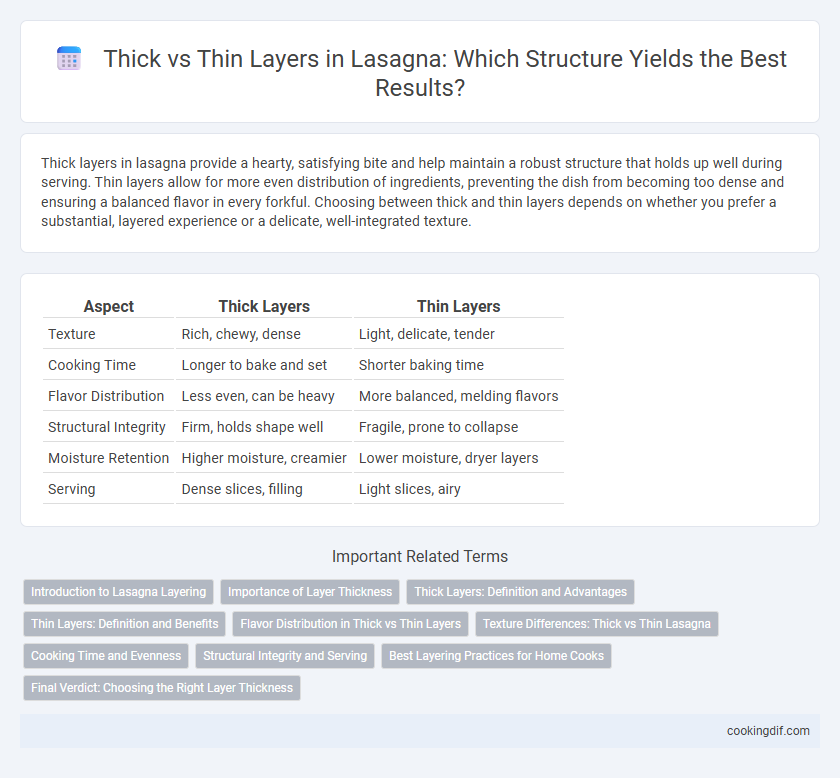Thick layers in lasagna provide a hearty, satisfying bite and help maintain a robust structure that holds up well during serving. Thin layers allow for more even distribution of ingredients, preventing the dish from becoming too dense and ensuring a balanced flavor in every forkful. Choosing between thick and thin layers depends on whether you prefer a substantial, layered experience or a delicate, well-integrated texture.
Table of Comparison
| Aspect | Thick Layers | Thin Layers |
|---|---|---|
| Texture | Rich, chewy, dense | Light, delicate, tender |
| Cooking Time | Longer to bake and set | Shorter baking time |
| Flavor Distribution | Less even, can be heavy | More balanced, melding flavors |
| Structural Integrity | Firm, holds shape well | Fragile, prone to collapse |
| Moisture Retention | Higher moisture, creamier | Lower moisture, dryer layers |
| Serving | Dense slices, filling | Light slices, airy |
Introduction to Lasagna Layering
Lasagna layering involves balancing thick and thin layers to achieve ideal texture and flavor distribution. Thick layers provide rich, hearty bites with dense fillings, while thin layers ensure even cooking and delicate blending of sauce and pasta. Optimal lasagna structure combines both approaches for a harmonious, satisfying dish.
Importance of Layer Thickness
Layer thickness in lasagna plays a crucial role in texture and flavor distribution, with thick layers offering a hearty, chewy bite while thin layers provide a delicate balance and even cooking. Properly calibrated thickness ensures the layers hold their structure without collapsing or becoming mushy, enhancing the overall mouthfeel. Optimizing layer thickness also influences sauce absorption and ingredient melding, creating a harmonious and satisfying dish.
Thick Layers: Definition and Advantages
Thick layers in lasagna refer to substantial, robust pasta and filling sections that create a hearty and satisfying texture. This method enhances flavor depth by allowing each layer to absorb sauces and seasonings more thoroughly, resulting in a richer taste experience. Thick layers also provide structural integrity, preventing the lasagna from becoming overly soggy and ensuring a cohesive, sliceable dish.
Thin Layers: Definition and Benefits
Thin layers in lasagna consist of finely spread pasta sheets alternating with delicate amounts of sauce, cheese, and fillings, creating a balanced and cohesive structure. This layering technique enhances even cooking and flavor distribution, preventing the dish from becoming overly dense or heavy. Thin layers yield a tender texture and allow each ingredient's flavor to shine through, resulting in a more refined and enjoyable eating experience.
Flavor Distribution in Thick vs Thin Layers
Thick layers in lasagna create a rich, concentrated flavor by allowing sauce and cheese to meld deeply within each stratum, enhancing intensity with every bite. Thin layers promote even flavor distribution, ensuring a balanced taste profile and preventing any single ingredient from overpowering the dish. Optimal lasagna structure depends on layering thickness, which influences texture and how flavors harmonize throughout the casserole.
Texture Differences: Thick vs Thin Lasagna
Thick layers in lasagna create a hearty, dense texture that emphasizes the rich creaminess of cheese and sauce, offering a substantial bite with each forkful. Thin layers, conversely, result in a lighter, more delicate structure that allows the flavors of individual ingredients like pasta, meat, and vegetables to blend seamlessly while maintaining a tender, melt-in-the-mouth consistency. The choice between thick and thin layers significantly influences the overall mouthfeel, with thick layers providing a chewy, substantial experience and thin layers highlighting smoothness and subtle flavor balance.
Cooking Time and Evenness
Thick layers in lasagna require longer cooking times to ensure the center is fully heated, often leading to uneven cooking where the edges may dry out. Thin layers promote more even heat distribution, reducing overall baking time and preventing sogginess by allowing moisture to evaporate more effectively. Optimal lasagna structure balances layer thickness to achieve uniform texture and flavor without compromising cooking efficiency.
Structural Integrity and Serving
Thick lasagna layers enhance structural integrity by providing firm, distinguishable strata that hold shape well during serving, minimizing collapse and sogginess. Thin layers create a more delicate texture and allow for even heat distribution but may risk losing definition when sliced, leading to less stable portions. Optimal serving balance depends on preferred texture and ease of cutting, with thicker layers favored for sturdier, well-defined servings.
Best Layering Practices for Home Cooks
Thick layers of lasagna provide a hearty, robust texture that holds well during baking, making them ideal for rich, chunky sauces and dense cheese blends. Thin layers, on the other hand, allow for more delicate flavors to shine and create a lighter, more balanced bite that cooks evenly and reduces the risk of sogginess. For home cooks, the best layering practice combines moderate thickness with careful ingredient distribution, ensuring each slice offers a well-structured balance of sauce, pasta, and cheese.
Final Verdict: Choosing the Right Layer Thickness
Thick layers in lasagna create a rich, hearty texture with distinct ingredient separation, enhancing the overall bite and flavor layering. Thin layers allow for more even cooking and a balanced distribution of sauce, cheese, and noodles, resulting in a lighter, more cohesive dish. Selecting the right layer thickness depends on desired texture and cooking time, with thick layers favored for depth and thin layers preferred for consistency and faster baking.
Thick layers vs Thin layers for structure Infographic

 cookingdif.com
cookingdif.com